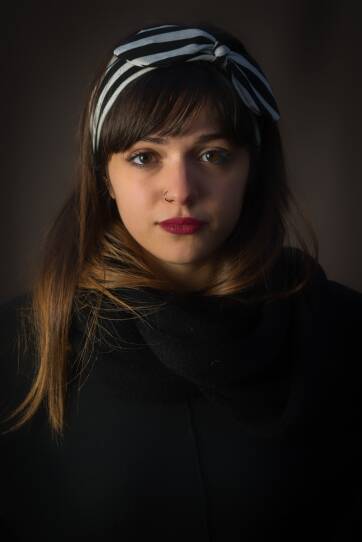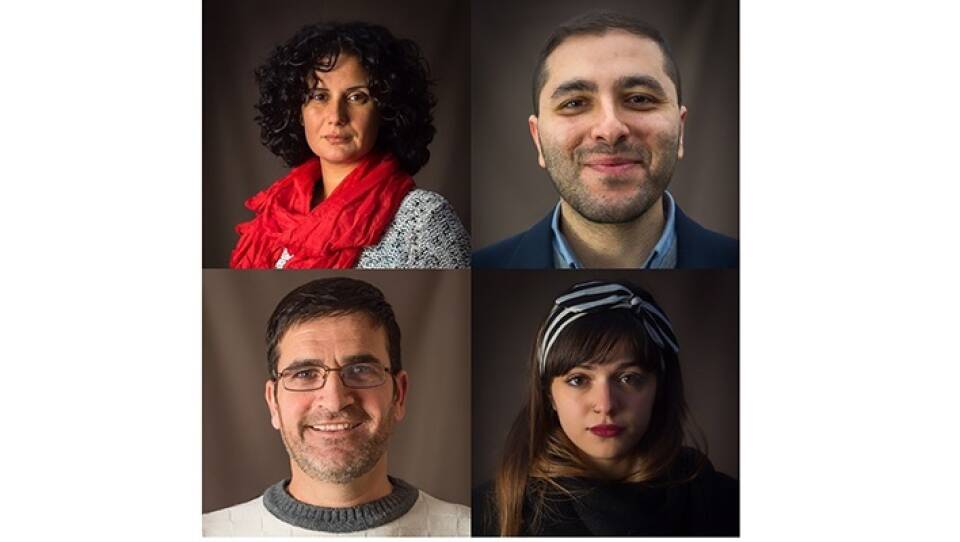To mark the occasion of World Refugee Day, Boston City Hall is hosting a reception that features an exhibit called "The Faces of Syrian Refugees." The exhibit has photographs of 20 Syrian refugees displaced by their country's civil war. The project is the work of Lasell College professor Dana Janbek, freelance journalist Amy Bracken, and photographer Michael Cohen. Cohen, a Boston native, discussed the exhibit with WGBH's Henry Santoro.
HENRY SANTORO: You came up with the concept for this project in early 2016. What was the light bulb moment?
MICHAEL COHEN: Well, it was interesting. I had been driven crazy by the Syrian refugee crisis for the last several years, and finally, I saw a documentary film that was shot in the Zaatari refugee camp in Jordan. And it occurred to me that all of the images that we had been seeing about Syrian refugees, we're seeing them at their worst — in the camps, trying to escape, and all of those terrible images that we all know. And I thought maybe we should see some Syrian refugees at their best.
SANTORO: What are some of the places that you traveled to find these people?
COHEN: So we worked first with UNHCR, the United Nations High Commission on Refugees, to find and identify Syrian refugees who had left because of the war and had resettled in other countries, primarily through Europe, and in Germany is where we first began. And our goal was to find refugees who had been in their new homes for at least a year, so they were now integrated as part of their new communities, and we were able to see how they had been surviving, and then thriving.

SANTORO: Could you tell as you were taking their photos that you were helping them to humanize the crisis that they had been through?
COHEN: When we first contacted them, they understood immediately what we were trying to do, and they were so welcoming. And what was really interesting was we were only looking for 20 Syrians, and we only had to find 20 Syrians, because everybody we talked to said "yes, I know what you’re trying to do and I really want to help."
SANTORO: But I bet finding 20 Syrians was not the easiest job on the planet.
COHEN: No, not at all, and we had a lot of help from a lot of NGOs in Germany, Canada and the United States, because once the Syrian refugees come out of the system at the very beginning, once they get settled, they sort of lose track. And so we had to sort of get in the network to find them.
SANTORO: Photographers often have to gain the trust of their subjects. Was that the case with this project?
COHEN: Oh absolutely, but we had a little bit of help, because on our team we have a journalist, and we have a researcher, and our researcher is Jordanian-born. She’s actually from here in Boston; she is a professor at Lasell College, her name is Dana Janbek, and she’s a fluent Arabic speaker. So we did the primary contact in Arabic, and so having the language was really helpful, gaining trust and gaining credibility.

SANTORO: Did you ask them to share their stories of what they had to do both physically and emotionally to leave their homeland behind?
COHEN: You know it’s interesting, I think we had a bit of conversation about what it took to get them out of Syria, but the primary goal, in order to humanize them and create connection with American audiences, was to learn about them as people. We wanted to know what their favorite TV shows are, we wanted to know what their favorite food is from their childhood, what some of their memories are of their grandparents, what brings them joy, what keeps them up at night. The kind of questions that we ask each other.
SANTORO: Describe the looks on some of their faces as you were photographing them.
COHEN: A lot of them were being photographed for the first time, so there was the standard nervousness, and to be honest with you, we made it a little bit difficult for them because when we did the photographs, they were primarily over the winter, and I didn’t want any of the images to look like they had been shot in winter, so we set up settings that didn’t look like winter. But we were outside, and it was about 30 degrees, so they were bundled up in coats and scarves until just before we took the pictures.

SANTORO: These pictures that are on view at Boston City Hall are not just small pictures that are hanging on the wall. These are, in some cases, larger than life.
COHEN: Well, we wanted to create some impact, and the impact is in both the number of images and the size of the images, and what you’ll find is that each refugee has two photographs: one that is full head-to-toe, and it’s printed six feet tall so it’s life-size, and then right next to it, also six feet tall, is a facial portrait, so, with eyes about …
SANTORO: Eyes the size of soccer balls.
COHEN: Yeah, and you know, you’re right there with them and you really feel like you’re there.

SANTORO: So let me ask you this: there is, of course, a political component to all of this, with President Trump’s travel ban that would restrict Syrians from coming into the United States that is working its way through the court system. And Boston Mayor Marty Walsh has been an outspoken critic of President Trump. Does any of this play a role in this exhibit being shown inside City Hall?
COHEN: There have been polls across the country that show that the majority of Americans don’t want Syrian refugees here. Our goal was to help educate people so that they can form an educated opinion. By seeing Syrian refugees at their best, and having an understanding how they can contribute to their communities, we’re teaching Americans something that perhaps they don’t already know.
SANTORO: Now, this exhibit is up through the end of the month, through June 30. How proud are you to have its premiere in the city that you live in?
COHEN: Well, we have had opportunities to have the exhibit in various other parts of the country where it will travel after Boston. But I was insistent that my hometown where I grew up and where I still live and love, that’s where we had to premiere this.




